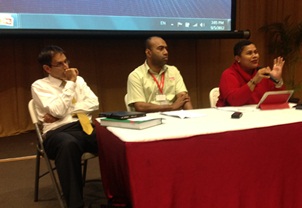
COMMENTARY: AUCKLAND (Pacific Media Watch): If robust debate is lacking in the Fiji media, there was certainly plenty of it at the Media and Democracy Symposium hosted at the University of the South Pacific.
In the aftermath, award-winning Communications Fiji journalist Vijay Narayan criticised conference organiser Dr Marc Edge, head of the USP journalism school, for asserting there is a practice of self-censorship in Fiji media - without providing proof from a specific study.
He and fellow reporters opened their FijiVillage.com website article yesterday with: “Everyone who is commenting on claims that there is widespread self-censorship in the country are making comments without any proper surveys conducted with journalists and media outlets.”
Indeed, Narayan was one of those vocal journalists at the conference who defended the Fiji media’s performance.
Self-censorship claim
But lawyer and outspoken regime critic Richard Naidu, also a former award-winning journalist, told Narayan at the symposium last week: “To suggest that the media is not operating under a set of self-censorship rules means that one of us is on the wrong planet.”
Narayan had said no one from his organisation was threatened or taken to the barracks. He said that since the lifting of the Public Emergency Regulations in January (which included strict censorship), his media organisation had not consulted the Ministry of Information before publishing.
“We have never called them [Ministry of Information] after the PER was lifted because we are comfortable about our decisions. We have never been taken to the camp, we have never appeared before the media tribunal,” he said, adding that “some people want to be heroes”.
He added that people like Naidu had not been in a newsroom and didn’t know what it was like.
Naidu retorted: “I worked in a newsroom – you can’t tell me I don’t know. If your organisation hasn’t gone to court I don’t think it’s doing its job.
“That’s why most media organisations have lawyers.”
Earlier in the panel discussion, representatives from the Fiji Sun and Fiji TV had told their stories of operating under censorship, before the lifting of the PER.
Before PER lifting
Josua Tuwere, deputy editor of the Fiji Sun, said censorship had been a good thing for them.
“It made us better journalists – we were forced to think about the repercussions of what we write,” he said.
While Tuwere said censorship was “all civil, no one was threatened ever”, Fiji TV's legal manager, Tanya Waqanika, had a different experience.
“We had our fair share of detention, fair share of threats,” she said.
She said Fiji TV operated under censorship by consulting with the Ministry of Information and obtaining prior permission for a story to avoid a backlash once it was broadcast.
She said it involved the ministry disallowing vital stories such as one on the Sigatoka hospital running out of water.
Issues remain
And even though the PER has been lifted, and Fiji TV was operating under a “business as usual” approach, it still consulted the government this year before running an advertisement from a client which featured brief footage of military men with guns.
She also said journalists were still afraid, and apprehensive to ask the questions they would normally ask.
“The journalists, they see the penalties. If you were in that situation, and there’s a court case currently against The Fiji Times, for any person, it freaks them out,” she said.
“No one wants to be fined.”
It resonates with Naidu’s claim it was of no impact that the decree had not been used against a journalist. He said the threat of the fines were penal enough - a journalist can be fined up to F$50,000 without the right to appeal.(The media decree provides penalties of $100,000 for media organisations, $25,000 for publishers and editors and $1000 for individual journalists).
Naidu described the six-month extension of Fiji TV’s licence “more like a good behaviour bond than a licence” while Waqanika said: “We just have to play it safe” and “We have to make a business decision”.
Now Narayan might be able to defend Communications Fiji and its website FijiVillage, and he is correct in his assertion that there has been no specific study on FijiVillage’s reporting, but perhaps he was ignoring the elephant in the room after hearing from Tuwere and Waqanika.
Evidence is in
His organisation has published an update today on the self-censorship debate. Narayan and fellow journalists Dhanjay Deo and Sarah Vamarasi claim there is no self-censorship, after checking with Fiji Times editor Fred Wesley and Fiji Sun publisher Peter Lomas, and their own editors.
That is hardly an academic study.
They also say Fiji TV says it will not comment. How they would have handled an honest answer may have been interesting.
This writer is undertaking a study into the print media in Fiji and other Pacific countries and there is extensive evidence that due to censorship, the print media in Fiji is suffering from self-censorship, as they are not sure where the line will be drawn by the government.
As Richard Naidu pointed out, the Media Industry Development Decree is full of subjective tests.
“What is and who decides what is against public order? What is and who decides what is against the public interest?” he said, referring to the decree’s punishments of fines and jail terms for those that fail to pass the test.
He also said the Code of Ethics enshrined in the decree was cumbersome”: “It does not work as a law. A law is required to be precise and accurate. A code is a guideline, a set of practices. A code cannot be enforced as a law.”
Drawing the line
The Permanent Secretary for Information Sharon Smith-Johns, to her credit, presented and sat through the whole two-day symposium, and was willing to be interviewed by any media or student journalist.
She gave me a small insight into where the government’s line might be.
She recognised it “would only be natural to have caution” for journalists coming out of censorship, but said: “Come out, there’s no need to be afraid”.
“It’s like all of us – the laws are only there for when you or I break them. And the chances of you or me ever breaking the law, apart from a speeding ticket or fine, it’s never going to happen because we know how to behave because we know what’s right.
“And so journalists know what’s right as well.
“It’s always that small one percent of people that want to push it to the limit, and that’s what it’s for. We want to be able to say: no, we want social harmony.”
But certainly more than that one percent feel intimidated. And what is it that the one percent are prone to publish against “social harmony”?
Smith-Johns said journalists need to “embrace what the next step is” but at least publicly, she hasn’t shone too bright a light on that area between the next step and the abyss should they step too far.
Media 'at fault'
She did say there must be caution: “We are very sensitive to the racial and religious issues here. And in the past, that’s always what has really got the media into trouble…
There’s been some hard stuff said in the media that you wouldn’t be allowed to run in the media anywhere in the world.”
Tuwere from the Fiji Sun agreed – he said the media “were irresponsible in their reporting, especially on issues of race”.
Perhaps if journalists steer clear of racial invective, which is the right thing to do anyway, they can get away with much more than they are currently attempting regarding analysis and criticism of the government.
At the symposium, a former head of journalism at USP Shailendra Singh said it was certainly not a cut and dried issue as some would like to make out.
“More cautious, more responsible and more circumspect, doesn’t mean self-censorship,” he said.
Perhaps this is not only a time to be more circumspect, but more courageous.
But that’s easy for me to say, writing from New Zealand.
As an example, Smith-Johns referred to the recent accusations of self-censorship levelled at newspapers by Shamima Ali, coordinator of the Women’s Crisis Centre.
Smith-Johns argued that when publishers did not run Ali’s press release they were not under any government directive and they made their own decision, probably based on readers’ tastes.
'Let public decide'
She said there was a lot of “irrelevant” information in the release despite the fact the women’s groups had a lot of good things to say.
“I would have preferred that ad to run because it was quite silly in a lot of ways and quite defendable from our point of view,” she said.
“Let the public see what they are saying. I’m sure a small percentage of people would agree with them and a large percentage would disagree.”
So Smith-Johns and the government are happy for the papers to run “silly” press releases, as people can make their own minds up. It seems, however, that they don’t trust people making their minds up about some other issues, hence the decree and its fines for those that “push it to the limit”.
From what we saw at the Media and Democracy Symposium - and the reporting of it in the press the next day - there are not a lot of limits being pushed.
Alex Perrottet is contributing editor for Pacific Media Watch, a masters student at AUT University researching comparative journalism in three Pacific countries and was at the Media and Democracy conference in Fiji.
This work is licensed under a Creative Commons Attribution-NonCommercial 3.0 New Zealand Licence.




